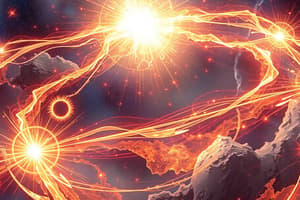Podcast
Questions and Answers
What creates magnetic fields?
What creates magnetic fields?
- Stationary charges
- High energy photons
- Moving charges (correct)
- Static magnetic materials
Which principle states that you cannot know both the exact position and momentum of a particle simultaneously?
Which principle states that you cannot know both the exact position and momentum of a particle simultaneously?
- General Theory of Relativity
- Wave-Particle Duality
- Uncertainty Principle (correct)
- Special Relativity
In the context of special relativity, what is considered constant for all observers?
In the context of special relativity, what is considered constant for all observers?
- Speed of sound
- Gravity
- Acceleration
- Speed of light in a vacuum (correct)
What is the unit of power in the International System of Units (SI)?
What is the unit of power in the International System of Units (SI)?
What does the equation $P = W/t$ represent?
What does the equation $P = W/t$ represent?
Which fundamental force is responsible for radioactive decay?
Which fundamental force is responsible for radioactive decay?
What is the formula for calculating Kinetic Energy?
What is the formula for calculating Kinetic Energy?
What does the Second Law of Thermodynamics state about heat flow?
What does the Second Law of Thermodynamics state about heat flow?
Which type of wave has oscillations that are perpendicular to the direction of wave travel?
Which type of wave has oscillations that are perpendicular to the direction of wave travel?
What is the relationship defined by Ohm's Law?
What is the relationship defined by Ohm's Law?
Which of the following statements is true about Strong Nuclear Force?
Which of the following statements is true about Strong Nuclear Force?
What happens to the entropy of a perfect crystal as temperature approaches absolute zero?
What happens to the entropy of a perfect crystal as temperature approaches absolute zero?
Which type of lenses diverges light rays?
Which type of lenses diverges light rays?
Flashcards are hidden until you start studying
Study Notes
Key Concepts in Physics
Fundamental Forces
- Gravitational Force: Attraction between masses; affects all objects with mass.
- Electromagnetic Force: Interaction between charged particles; responsible for electricity and magnetism.
- Weak Nuclear Force: Responsible for radioactive decay; operates at subatomic levels.
- Strong Nuclear Force: Holds protons and neutrons together in the nucleus; strongest force but short-range.
Laws of Motion (Newton's Laws)
- First Law (Inertia): An object at rest stays at rest, and an object in motion remains in motion unless acted upon by a net force.
- Second Law (F=ma): The acceleration of an object is directly proportional to the net force acting on it and inversely proportional to its mass.
- Third Law (Action-Reaction): For every action, there is an equal and opposite reaction.
Energy
- Kinetic Energy (KE): Energy of motion; KE = 1/2 mv² (m = mass, v = velocity).
- Potential Energy (PE): Stored energy based on position; gravitational PE = mgh (h = height).
- Conservation of Energy: Energy cannot be created or destroyed, only transformed from one form to another.
Thermodynamics
- First Law: Energy is conserved; internal energy change equals heat added minus work done by the system.
- Second Law: Heat naturally flows from hot to cold; entropy of an isolated system always increases.
- Third Law: As temperature approaches absolute zero, the entropy of a perfect crystal approaches zero.
Waves and Sound
- Wave Properties: Wavelength, frequency, amplitude, speed.
- Types of Waves:
- Transverse Waves: Oscillations perpendicular to wave direction (e.g., light).
- Longitudinal Waves: Oscillations parallel to wave direction (e.g., sound).
- Sound: A longitudinal wave that travels through a medium; speed varies with medium density and temperature.
Light and Optics
- Reflection: Bouncing of light off surfaces; governed by the law of reflection (angle of incidence = angle of reflection).
- Refraction: Bending of light as it passes between different media; described by Snell's Law.
- Lens Types:
- Convex: Converges light rays; can form real or virtual images.
- Concave: Diverges light rays; typically forms virtual images.
Electricity and Magnetism
- Electric Charge: Fundamental property of matter; exists as positive and negative charges.
- Ohm's Law: V = IR (V = voltage, I = current, R = resistance).
- Magnetic Fields: Created by moving charges; depicted using field lines.
Quantum Mechanics
- Wave-Particle Duality: Particles exhibit properties of both waves and particles.
- Uncertainty Principle: Cannot simultaneously know the exact position and momentum of a particle.
Relativity
- Special Relativity: Time and space are relative; the speed of light is constant in a vacuum for all observers.
- General Relativity: Gravity is a curvature of spacetime caused by mass.
Important Units
- Mass: Kilograms (kg)
- Force: Newtons (N)
- Energy: Joules (J)
- Power: Watts (W)
- Voltage: Volts (V)
- Current: Amperes (A)
Key Equations
- Kinematics: v = u + at; s = ut + 1/2at²
- Work Done: W = Fd cos(θ)
- Power: P = W/t
This overview provides a foundational understanding of key physics concepts, laws, and equations essential for further study.
Fundamental Forces
- Gravitational Force: The force of attraction acting between masses; affects all objects with mass, influencing orbits and falling objects.
- Electromagnetic Force: Interaction among charged particles; governs electricity and magnetism, allowing for electric circuits and electromagnetic waves.
- Weak Nuclear Force: Plays a crucial role in processes like radioactive decay; operates at very short distances, affecting particle interactions in the nucleus.
- Strong Nuclear Force: The strongest force, holding protons and neutrons in the nucleus together; it operates at short ranges (within atomic nuclei).
Laws of Motion (Newton's Laws)
- First Law (Inertia): An object remains in its current state (rest or motion) unless affected by a net external force, illustrating the concept of inertia.
- Second Law (F=ma): Describes how force, mass, and acceleration interact; the acceleration is proportional to the net force and inversely proportional to the object's mass.
- Third Law (Action-Reaction): Highlights that forces occur in pairs; every action produces an equal and opposite reaction.
Energy
- Kinetic Energy (KE): The energy associated with motion, calculated as KE = 1/2 mv², where m is mass and v is velocity.
- Potential Energy (PE): Stored energy due to an object's position, with gravitational potential energy expressed as PE = mgh, where h is height above a reference point.
- Conservation of Energy: A fundamental principle stating that energy in a closed system can be transformed but not created or destroyed.
Thermodynamics
- First Law: States the conservation of energy principle; the change in internal energy is equal to heat added to the system minus work done.
- Second Law: Describes the natural direction of heat flow (from hot to cold); introduces the concept of entropy, which tends to increase in isolated systems.
- Third Law: As temperature nears absolute zero, the entropy of a perfect crystal approaches zero, suggesting perfect order at absolute zero.
Waves and Sound
- Wave Properties: Key characteristics include wavelength, frequency, amplitude, and speed, which collectively describe wave behavior.
- Types of Waves:
- Transverse Waves: Oscillations occur perpendicular to the direction of wave travel; examples include light waves.
- Longitudinal Waves: Oscillations occur parallel to the wave's movement; sound waves exemplify this type.
- Sound: A longitudinal wave traveling through a medium; its speed is influenced by medium density and temperature.
Light and Optics
- Reflection: The bouncing of light off surfaces; follows the law of reflection, where the angle of incidence equals the angle of reflection.
- Refraction: The bending of light when passing through different media, explained by Snell's Law.
- Lens Types:
- Convex Lenses: Converge light rays; can create both real and virtual images depending on object placement.
- Concave Lenses: Diverge light rays; predominantly produce virtual images.
Electricity and Magnetism
- Electric Charge: A fundamental characteristic of matter resulting in positive and negative charges, essential for electrical interactions.
- Ohm's Law: Describes the relationship between voltage (V), current (I), and resistance (R) in an electrical circuit, expressed as V = IR.
- Magnetic Fields: Generated by electric currents and moving charges, represented visually through magnetic field lines.
Quantum Mechanics
- Wave-Particle Duality: Suggests that particles can exhibit both wave-like and particle-like properties, particularly at the quantum level.
- Uncertainty Principle: Asserts that it is impossible to precisely measure both the position and momentum of a particle simultaneously.
Relativity
- Special Relativity: Introduces the concept that time and space are not absolute but relative; highlights that the speed of light remains constant for all observers in a vacuum.
- General Relativity: Expands on special relativity by presenting gravity as a curvature of spacetime caused by mass.
Important Units
- Mass: Measured in kilograms (kg).
- Force: Measured in newtons (N).
- Energy: Measured in joules (J).
- Power: Measured in watts (W).
- Voltage: Measured in volts (V).
- Current: Measured in amperes (A).
Key Equations
- Kinematics: Describes motion with equations v = u + at and s = ut + 1/2at².
- Work Done: Calculated as W = Fd cos(θ), where F is force, d is distance, and θ is the angle between force and motion direction.
- Power: Defined as P = W/t, representing the work done over time.
Studying That Suits You
Use AI to generate personalized quizzes and flashcards to suit your learning preferences.




